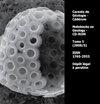Discussion of Laya et al. (2021), Dissolution of ooids in seawater-derived fluids - an example from Lower Permian re-sedimented carbonates, West Texas, USA [Sedimentology 68(6), 2671-2706]
IF 1.5
4区 地球科学
Q2 GEOLOGY
引用次数: 0
Abstract
This discussion reassesses earlier interpretations of calcareous turbidites from the subsurface Spraberry Formation of the Happy Field (Garza County, NW Texas). It is based on routine petrographic analyses with a standard microscope. The succession of diagenetic products in this deep water setting were a little initial cementation by low magnesian calcite (LMC) and then the partial or complete leaching of both aragonite and high magnesian calcite (HMC) allochems facilitated by the presence of a residual primary intergranular porosity. This contradicts Laya et al.'s (2021) claim that cementation left no residual intergranular porosity so further leaching of the ooids would not have been possible. Instead the study made for this discussion with the same thin sections found residual primary intergranular porosity remains as evidenced by some of their photomicrographs. Most thin sections with porous grainstones have 1) collapsed molds that exhibit evidence of little initial cementation and 2) measured permeability values that range from some mD to some tens of mD. Isopachous LMC cements occur in almost all thin sections lining the margins of most intergranular pores. As these cements do not fully fill the pores, there is permeable well-connected residual primary porosity with no significant LMC cement in the secondary moldic porosity. Compaction affects the allochems and, where these are partially leached, intergranular and moldic porosities. Dissolution of aragonite (a major component) and HMC (possibly a minor component) was probably not coeval. The order of paragenetic sequence of this discussion study was: 1) LMC cementation; 2) aragonite leaching facilitated by oxidation of the organic matter in the "biocrystals" of bioclasts and oolitic cortices; 3) compactional brecciation, which was first mechanical, and then chemical causing local collapse of the molds of some of the largest pores. It was governed by cementation initially in a shallow burial diagenetic setting and then leaching whereas chemical compaction marks a slightly deeper burial diagenetic setting. The final event was marked by oil migration into the Happy Field reservoirs, freezing the calcium carbonate diagenesis. The theory of Laya et al. (2021) of the leaching of ooids in directly "seawater-derived fluids" is unsupported by the paragenetic sequence described above.Laya et al.(2021),海水衍生流体中流体溶蚀作用的讨论——以美国西德克萨斯州下二叠统再沉积碳酸盐岩为例[沉积学68(6),2671-2706]
本文重新评估了早先对Happy Field (Garza County, NW Texas)地下Spraberry组钙质浊积岩的解释。它是基于常规岩石学分析与标准显微镜。在该深水环境中,成岩产物的演替是低镁方解石(LMC)的初始少量胶结作用,然后在残余原生粒间孔隙的促进下文石和高镁方解石(HMC)的部分或完全浸出。这与Laya等人(2021)的说法相矛盾,他们认为胶结作用没有留下残留的粒间孔隙,因此不可能进一步浸出鲕粒。相反,本研究用相同的薄片发现了残余的原生粒间孔隙,一些显微照片证明了这一点。大多数具有多孔颗粒岩的薄片具有1)塌陷的模子,显示出很少的初始胶结作用;2)测量的渗透率值从几mD到几十mD不等。大多数粒间孔隙边缘的几乎所有薄片都有等厚的LMC胶结作用。由于这些胶结物不能完全填满孔隙,因此存在可渗透的连通良好的残余原生孔隙,次生模态孔隙中没有明显的LMC胶结物。压实作用影响同种化学,在它们部分浸出的地方,影响晶间孔隙和模态孔隙。文石(主要成分)和HMC(可能是次要成分)的溶解可能不是同时发生的。本研究共遗传序列顺序为:1)LMC胶结;2)生物碎屑和鲕状皮质“生物晶体”中的有机物氧化促进文石浸出;3)压实角化作用,首先是机械性的,然后是化学性的,造成模具中一些最大孔隙的局部塌陷。初期为浅埋成岩环境下的胶结作用,后为淋滤作用,而化学压实作用则标志着略深埋成岩环境。最后的标志事件是石油运移到Happy油田储层,冻结了碳酸钙成岩作用。Laya等人(2021)关于直接“海水衍生流体”中流体浸出的理论不支持上述共生序列。
本文章由计算机程序翻译,如有差异,请以英文原文为准。
求助全文
约1分钟内获得全文
求助全文
来源期刊

Carnets De Geologie
Earth and Planetary Sciences-Geology
CiteScore
2.90
自引率
14.30%
发文量
21
审稿时长
>12 weeks
期刊介绍:
Information not localized
 求助内容:
求助内容: 应助结果提醒方式:
应助结果提醒方式:


